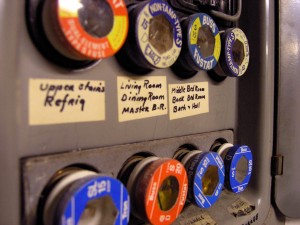Electrical Inspections – Breakers And Fuses
 One sure sign that you need to have an electrical inspection done on your building or home is if you experience shortages or outages. Drains on power are also a sign there is too much electricity flowing through your wiring.
One sure sign that you need to have an electrical inspection done on your building or home is if you experience shortages or outages. Drains on power are also a sign there is too much electricity flowing through your wiring.
Older wiring and switchboards will eventually degrade to the state where fire easily starts or shorts pass through the wiring in the home causing fires.
Electrical panels (switchboard or breaker boxes) are located on the outside or inside of the building. The main power lines from the electricity provider lead into the building through this switchboard. The switchboard houses circuit breakers and fuses. Each fuse or circuit breaker connects to a different area of wiring in the building.
The breaker box protects the electrical system in the building by cutting off the power in the event there is an overload on the system. A circuit breaker will trip or the fuse will blow, cutting off the power to avoid damage.
The circuit breaker can be switched back on, but when a fuse blows it must be replaced with a new one.
Always turn off the main power switch if you are changing a fuse as well as turning off all electrical appliances and light switches that are connected to the blown fuse.
Find out what electrical switches and appliances the fuse or circuit breaker protects. Switchboards are normally labeled for easy identification. If yours is not, you will want to make sure it is marked clearly for next time.
Electrical inspections are important for every property owner. Problems can be seen sometimes, but most of the time the issues are not apparent to the normal person who has not had the training to spot them.
Some signs that you may have a problem include when a fuse is blown or a circuit breaker gets tripped. If the circuit breaker is tripped, switch it back to the on position. But if the fuse is blown, it will need to be replaced.
Steps to Changing Out A Fuse:
- Locate the main breaker box. The breaker box is the switchboard that all the wires attach to. It may be located inside or outside the building.
- Turn off the main power switch at the switchboard. The main switch is the largest switch usually at the top of the switchboard and should be clearly marked.
- Find out where each circuit and fuse connects to by looking inside the switchboard. Some switchboards have been clearly marked as to what areas of the home the electricity runs to.
- Visually inspect the fuses. If a fuse has blown, the switch will automatically swing to the off position. If it is not obvious which fuse has blown, inspect each fuse one at a time.
- Once you have found the blown fuse, turn off all the lights and unplug all appliances connected on that circuit. Make sure the switch on the breaker box is still in the off position.
- Replace the fuse wire. Be sure you use the correct current rating fuse wire. The current rating is generally indicated on the front of the fuse carrier.
-
- Lighting circuits typically use 5 amp, but not greater than 10 amp fuse wire.
- Socket outlets use 10 amp but not greater than 15 amp fuse wire.
- Large appliances use a larger size fuse.
- Cut off any excess fuse wire.
- Place the fuse back in its slot and turn back on the main power switch.
Once you place the new fuse and turn on the main power, the fuse may end up blowing again. If it does, you will want to be sure to call in an electrician.
If the fuse keeps blowing, there are probably problems that you can’t readily find. You need to be sure you don’t have an electrical short going on somewhere that can cause a fire hazard or electrical shock to those in the building.






